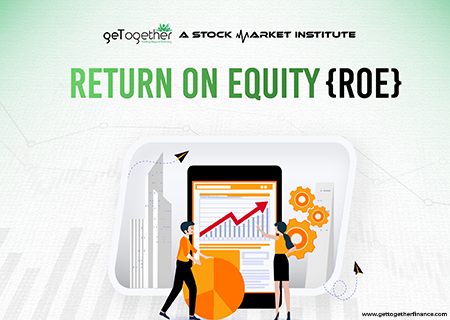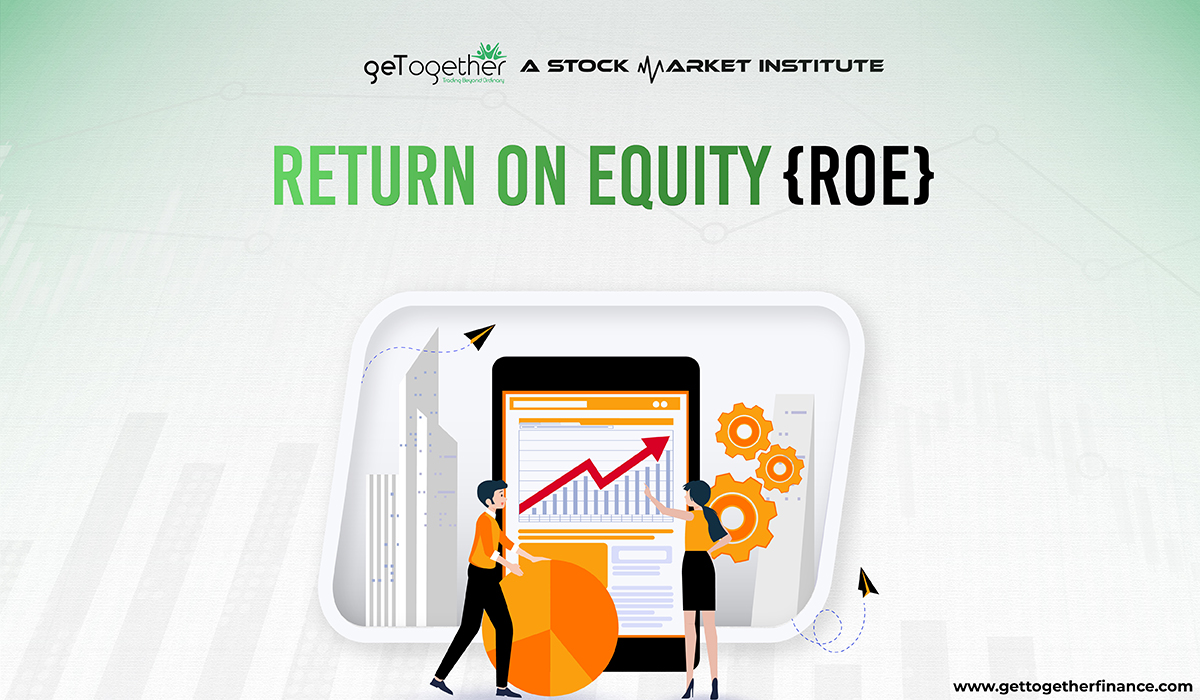RETURN ON EQUITY ( ROE )


Preface
While investing in the stock market, have you ever come across the term “return on equity”? Well, it is one of the common terms that is considered by investors. In abstract terms, ROE is a significant way to measure financial performance and a company’s profitability. It’s like how much returns you get for your holdings. You can use ROE to compare companies in the same industry or sector and see who’s giving the best returns. But is ROE enough to tell you everything about a company? Let’s take a step forward to grab some exciting knowledge on return on equity and how it is crucial in making better-informed investment decisions.
What is Return on Equity?
Even Warren Buffett said, “Focus on return on equity not earnings per share”. As it is a vital factor to consider for an investor before making sound investment decisions. In simple language, we can say that return on equity is a profitability ratio that tells about the profit that the company is making on the shareholder’s equity. It is one of the vital parameters for gathering information about the company and understanding how a business issues capital and generates returns. Some of the sectors that have majorly experienced high ROE in India are pharma, IT, and banking.
Now you must probably have an idea about what ROE is, so let’s turn the page and understand how we calculate it.
Calculation of ROE
Just like before getting into the stock market, we need to understand the basics of stock market. Similarly, before understanding the calculation of the ROE, we need first to understand a few terminologies that are included in the formula.
The very first term that needs to be understood is annual net income, the net income is a bottom-line profit of a company. It can be obtained by considering the company’s income statement for the year. You can calculate it by deducting the operational expenses, interests, and taxes from the annual revenue. So the formula can be written as:-
Net income = Gross revenue – Expenses(Inclusive of interest expenses for outstanding debts) – Taxes
The second very essential term is shareholder’s equity, which is an investor or shareholder claim over the company’s assets after adjusting liabilities. You can obtain it from the balance sheet of the company, by using a very simple formula i.e. Total shareholder’s equity= Total assets- Total liabilities.
It is very crucial to understand that there will be a slight mismatch in the equity value between the income statement and the balance sheet. Therefore, to overcome this it is advisable to use the average equity in the particular year.
So, that now when you have understood the terms, let’s quickly look at how we can calculate the ROE of the company.

Hence, the Calculation of ROE is achievable only if both the net income and the stockholders’ equity of the company are positive. If Rs. 5 from a shareholders’ stock generates Rs. 1 as net income, the ROE for that company would be 20% which is a good ROE but depends on the sector it belongs to.
Let’s understand with an example, below mentioned is a table of a Company ABC Ltd:
| Parameter | Amount ( Rs ) |
| Net income | 5.8 lac |
| Shareholder’s equity | 3.5 lac |
Therefore,
- Return on equity ratio = 3,50,000 / 5,80,000 = 3:5
Let’s calculate in per%
- Return on equity = 0.60 x 100 =60%
What is an ideal ROE?
Just Like before visiting any new restaurant you always check the rating. And we always dig for the restaurants that have 5 stars. Because That’s our ideal rating to judge the restaurant that can turn into a good one. Similarly, an ideal ROE totally is only based on the particular sector that the company belongs to. Every sector has its different ideal ROE. Usually, an ROE of 15-20% is considered good. But in some sectors, ROE greater than 25 is considered good.
What is the significance of ROE?

You don’t need to play “kaun banega crorepati” in order to become a crorepati even if the stock market can make you one. But for that, you need to know how to make smart investment decisions in the market. As we have mentioned above, Return on equity (ROE) is a very crucial aspect. So let’s get quickly into the points that will tell us the significance of ROE.
1. ROE shows you the financial soundness of a firm. For example, companies with a higher return on equity than peers may generate higher returns for their shareholders.
2. You may compare a company’s ROE across different periods to track the performance of the company’s management.
3. To identify multi-bagger stocks, You may look for companies that had steady and rising ROE over the past five to seven years.
4. Companies with a Return on Equity (ROE) of around 15%-20% over five or more years could be a good investment option.
High ROE stocks in India:
Evaluating a company and making investment decisions based on it totally depends on each investor. For creating a clear visual and to give you a slight idea about the companies that have high ROE in India we have created a chart below, so let’s get into it and find some top-notch ROE stocks in India.
| Stock’s Name | Return on Equity |
| Tata Consultancy Services (TCS) | 46.9% |
| Castrol India Ltd. | 45.9% |
| Coal India | 56.0% |
| Hindustan Zinc | 44.5% |
| Infosys | 31.8% |
Why is ROE considered an imperfect scale?

We believe that ROE tells us the apt financial performance of the company but is it really a perfect scale to consider? Most experts agree that return on equity is a faulty scale to measure a company’s success or failures for the following reasons –
1. ROE for a company receives a boost every time when shareholder equity increases. Thus, if investment in the company reduces, it can positively affect the return on equity. So yes, it is a fluctuating parameter.
2. A high ROE fails to differentiate between companies with good management and those flooding in debt. This is because increased debt leads to a reduction in the equity figures for a company. With decreased equities, the ROE increases. Therefore, although the company has high debts, an outsider looking at the ROE would need to sense the actual condition of the company.
3. Another major issue with return on equity is that it only takes into account the tangible assets of a firm. Therefore, if a firm holds patents, trademarks, brand names, and other intangible property, the same is left out when calculating its ROE. This results in inaccurate predictions of a company’s asset management.
4. Supervisors of the company can easily manipulate the ROE. Doing so is not only possible but also beneficial in many cases as the growth of this metric is linked to the higher compensation of high-level executives. Often, a good return on equity is increased for personal gain by completely ignoring the negative impact that a move creates on the business as a whole.
5. An individual lacking additional knowledge about the company may form a faulty impression regarding the brand from its ROE which may have increased for some reason.
What is the limitation of ROE?
From childhood, we have heard that “excess of everything is harmful”. We can assess a company’s financial performance by ROE but it doesn’t mean it is the only parameter to look for. We have advantages of ROE, but we do have limitations too.
1. ROE is used to compare the performance of companies in the same industry. But You cannot measure the performance of companies in different sectors.
2. ROE may be higher for new companies and the capital requirements are higher in the initial days.
3. Companies may manipulate ROE through accounting tools like decreasing the depreciation rate or increasing the particular project life.
4. Companies may raise capital through debt (borrowings) which ultimately increases the ROE.
Conclusion
Just like the way our parents looked at the school’s past grades and performance before enrolling us in the school. Similarly, ROE is one of the grades of a company’s financial performance. A good role denotes that the company is doing well and so the company can give good returns on the investments, but it is very important to understand that, the way school’s education is not only the factor to consider and hence other than that their curricular activities and so on parameters are important.
Similarly, only ROE is not the factor that can tell you about the company’s performance. Therefore it is necessary to combine other factors too. Factors such as balance sheet, profit, and loss report are considered.
FAQs
1. What happens when ROE is negative?
If a company’s ROE is negative, it means that there was negative net income for the period (i.e., a loss). This implies that shareholders are losing their investment in the company i.e. an organization is having issues with debt, asset retention, or both. Usually, For new and growing companies, a negative ROE is often to be expected; however, if negative ROE continues it can be a sign of trouble.
2. What causes high ROE?
A rise in return on equity can be experienced by several factors that include effective financial management, healthy profit margins, efficient asset utilization, cautious financial leverage, operational excellence, innovation, growth, tax management, and strategic dividend policies. Such factors maximize profitability and signal the efficient use of shareholders’ equity. However, it’s vital to consider industry context and overall financial health before interpreting a high ROE as the sole indicator of success or making investment choices.
3. What is the difference between ROE (Return on Equity) and ROA (Return on Asset)?
Return on assets (ROA) and Return on equity (ROE) are similar in that they try to gauge how efficiently the company generates its profits. However, whereas ROE compares net income to the company’s net assets, ROA compares net income to its assets alone, without deducting its liabilities. In both cases, companies in industries in which operations require significant assets will likely show a lower average
The higher of ROE reflected the higher level of profit that obtained by the company owner. The high profit level of company owners will encourage to increase the company’s ability to pay dividends and one can generate some passive income through dividend investing also, You can read more about Generating Passive Income Through Dividend Investing by clicking – here
